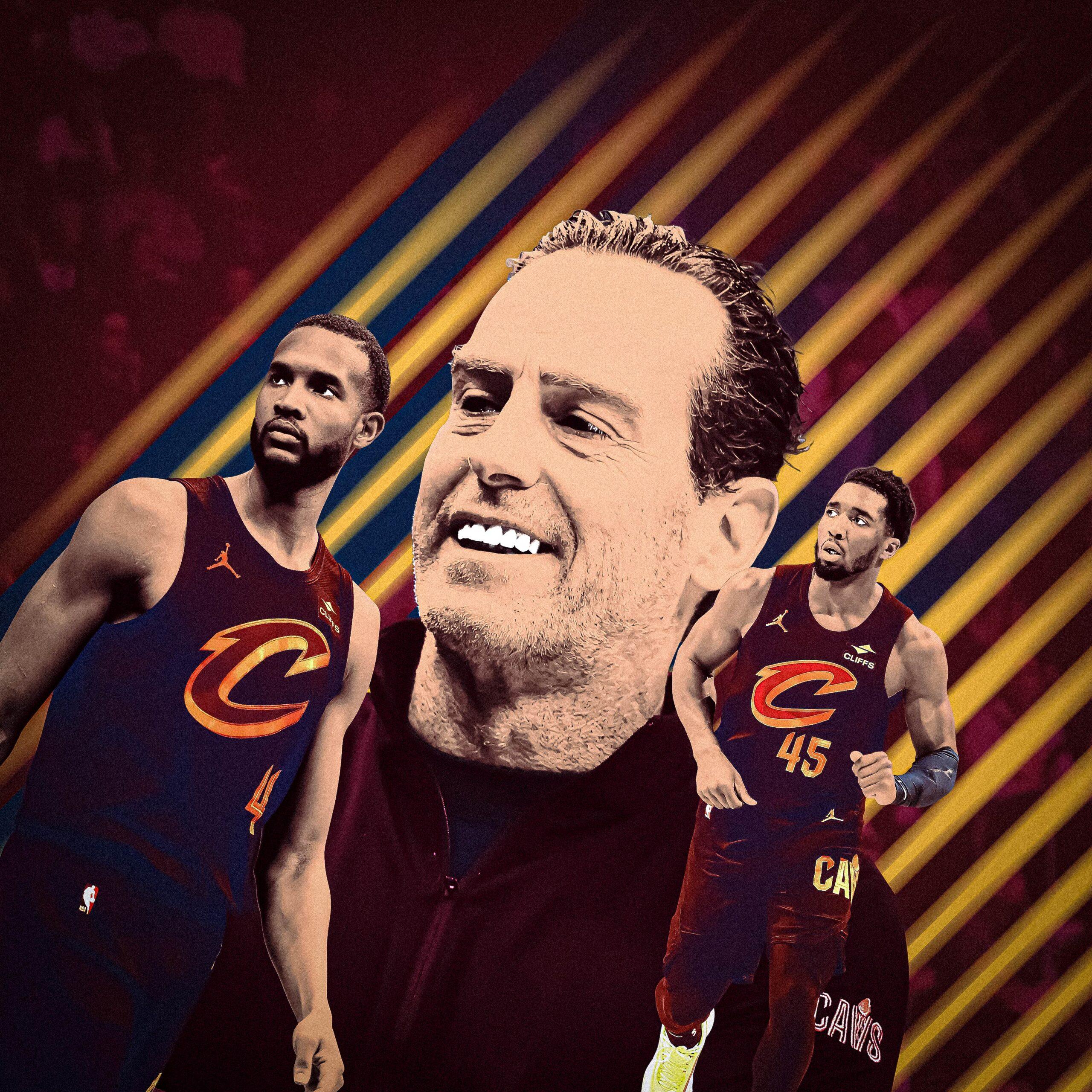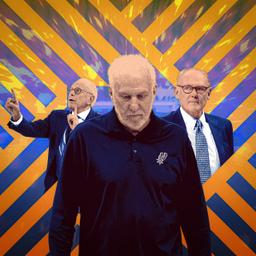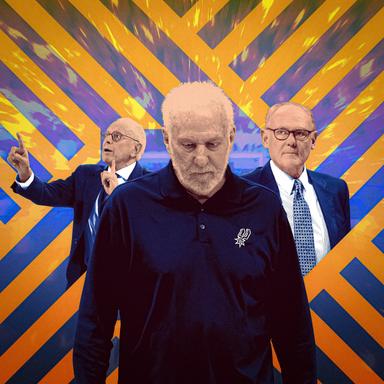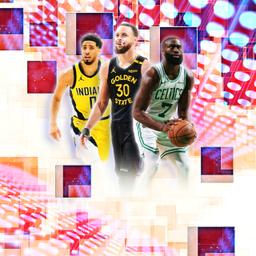
The man at the podium looks pained, but steady. Gray in his temples, creases in his forehead, voice soft but projecting calm. Kenny Atkinson has lived a hundred basketball lives across two continents, but he’s never encountered a moment quite like this one. Head coach of a top-seeded team with eyes on the Larry O’Brien Trophy, now staring down an 0-2 deficit. And yet, moments after his injury-ravaged Cavaliers lost Game 2 of their second-round series on a backbreaking Tyrese Haliburton 3, Atkinson opens his remarks not by lamenting what went wrong but by emphasizing all that went right. “I love how they competed,” he says of his players. “I love how they fought.”
Through 82 games and one playoff series, Atkinson’s Cavaliers looked like a surprising juggernaut. On offense, the ball in perpetual motion, tiki taka on the banks of Lake Erie. On defense, pesky guards forcing the ball into a thicket of doom, drives stalling out before the 14-foot fortress that makes up the Cavs’ front line. Cleveland won 64 games, tied for the second-highest win total of any team since 2020. They entered the playoffs with home-court advantage through the entirety of the Eastern Conference playoffs, and they opened with a sweep of the Miami Heat that was more lopsided than any other series in NBA history, winning each game by an average of 30.5 points. “Damn,” Heat coach Erik Spoelstra, on the short list of greatest coaches of this century, said after Game 4, “it was humbling.”
And yet. Through two games, the Cavs are being humbled themselves. Now they face two road games in Indiana up next. Game 2, in particular, felt devastating. Playing without two of their three All-Stars, Darius Garland and Evan Mobley, the Cavs roared to a massive lead, before allowing Indiana to slowly creep back into the game. Holding on, tying the series, and living to give Garland and Mobley more time to get healthy would have left Cleveland in solid position to advance. Instead, they allowed Haliburton to rebound his own missed free throw and hit the game-winner. “We outplayed them for most of the game,” Atkinson insists afterward. “We ran out of gas.” They also wasted a masterful 48-point performance from their lone healthy star, Donovan Mitchell. Now the Cavs are staring down the risk of getting swept.
Sitting at the podium after the loss, Atkinson appears rueful at times. “My only regret is not playing more guys,” he says. And at others, resolute. All year, Atkinson’s team has rewarded his belief. He arrived in Cleveland as a coach in need of a second chance. The roster he inherited needed one, too. Maybe together, they could prove that neither had hit their ceiling. That both were made of the kind of stuff that propelled teams deep into the postseason.
From October to April, Atkinson and his players unlocked something special in each other. The Cavs tore through their schedule. Atkinson won the NBA’s Coach of the Year. But now that injuries have hobbled the roster and the calendar has turned from April to May, both will need to find new layers of resilience in order to keep their dream season alive.
Fortunately for Cleveland, Atkinson has experience doing just that.
Atkinson’s upbringing is the stuff of sports movies. The seventh of eight boys, split between just two bedrooms, Atkinson as one of the runts fighting for any chance he could get to compete on the court with his older brothers. “He was different,” says Phil Weber, who grew up in the same neighborhood and later coached alongside Atkinson with the Knicks. “His brothers weren’t as quick as he was.” Weber points to research showing that in large families, younger siblings are often the most athletic. “Because [as] you try to keep up,” he says, “you become faster.”
A tough defender and excellent 3-point shooter, Atkinson played four years at Richmond before a long career in Europe—France, Spain, Italy, Germany. He transitioned quickly from playing to coaching, getting his start as an assistant with a club in Paris, followed by a job as director of player development for the Houston Rockets under Rick Adelman. In 2008, the Knicks hired Mike D’Antoni, then known as the architect of the “Seven Seconds or Less” Phoenix Suns, a team that ushered the NBA out of the age of grinding defense and post play into the pace-and-space era that has lasted until this day. Weber, who’d grown up a close friend of Atkinson’s brothers and a friendly acquaintance of Atkinson himself, remembers getting a call. “What are they doing with the staff?” Weber remembers Atkinson asking.
In truth, Weber knew nothing about Atkinson as a coach. “I’d never saw him in coaching situations.” But he knew enough about him to feel confident. “He made himself a great player,” Weber says. “And I knew he wanted to continually improve. And he was very curious, which I think is one of the traits of successful people.”
Something else that made Atkinson a fit in New York: He was coming from Houston, a franchise at the forefront of the analytics revolution under Daryl Morey. “He put numbers to what we felt,” Weber says. D’Antoni’s coaching philosophies were based on vibes, but would soon be backed up by statistics. “We were already doing it with the 3s and the spacing,” Weber says. “So he fit right in with the way we were already thinking.”
Atkinson later made his name in New York by working with young guards often left out of the rotation. In particular, Jeremy Lin. “They worked together constantly,” Weber says. Atkinson was in his early 40s, just a few years past the end of his playing career, still in excellent shape. “Kenny would simulate in-game actions,” Weber says. “He would go out and drive and attack. … Kenny was great with insights on how to become a point guard, because he had been a point guard his entire life.” When Lin erupted, rocketing from the end of the bench to the talk of the league over a two-week stretch forever known as “Linsanity,” Atkinson saw the fruits of his own labor. “When you’re around him,” Lin later said of Atkinson, “you kind of understand there’s something different about him. His energy, his passion, the juice he approaches his work with.”
Neven Spahija remembers waking up in a downtown Atlanta hotel one morning in the fall of 2014, nervous and eager to impress. The Croatian had built a career as one of the most well-respected coaches in Europe, but was now getting ready for his first day on the job as an assistant with the Atlanta Hawks. “I had dinner with other coaches the night before,” he says, “and I asked when I needed to be at the facility in the morning.” They told him their first meeting was at 9 a.m. Spahija remembers showing up an hour early, eager to defy any stereotypes that Europeans lacked American punctuality. But when he got to the practice facility, he saw Atkinson sitting in his office, already at the computer. He’d been there since 6:30. Spahija, now the head coach of Reyer Venezia in Italy, laughs as he remembers it now. “I felt so ashamed.”
Spahija had just been hired to join Atkinson on Mike Budenholzer’s staff. That year, the Hawks went on to win 60 games without a true superstar, as a team whose entire starting five was named Eastern Conference Player of the Month, a team that made All-Stars out of both Kyle Korver and Jeff Teague. Like this year’s Cavaliers, the Hawks’ core had seemed to reach its ceiling as a middling playoff team and no more. And like with this year’s Cavaliers, the coaching staff managed to elevate its roster to a level most in the league never believed they could reach. Budenholzer won Coach of the Year and went on to win a title coaching the Milwaukee Bucks. But the longest-lasting legacy of that team might be the list of coaches who sat further down the bench. Four assistants went on to become NBA head coaches. Atkinson, Darvin Ham (Lakers), Taylor Jenkins (Grizzlies), and Charles Lee (Hornets).
Immediately, Spahija could tell Atkinson was on his way to a head coaching gig of his own. “He had an amazing work ethic and self-discipline,” Spahija says. Every morning, Atkinson beat all the other coaches to the office. And every day after practice, he would get in a workout of his own. “Running, studying film, usually at the same time.” Spahija had been on staffs with so many of the best coaches in Europe, but when he arrived in Atlanta, he says, “I realized in the first week that this was another level.” That Hawks team reached the Eastern Conference finals before getting swept by LeBron James and the Cavaliers twice in a row. When job openings came up, Spahija participated in the typical coaching gossip. He remembers asking Atkinson who he thought would get the Nets job.
“The next morning,” Spahija remembers, “in our meeting, Coach Bud said, ‘I would like to announce that our friend Kenny is the next coach in Brooklyn.’”
For his first head coaching job, Atkinson inherited a situation that looked stunningly bleak. The Nets, then owned by incompetent Russian oligarch Mikhail Prokhorov, were bereft of any assets after their infamous trade for Paul Pierce and Kevin Garnett. The roster was built around Brook Lopez, Bojan Bogdanovic, and Atkinson’s old protégé, Jeremy Lin. (Competent professional basketball players, all of them, but not the kind who belong anywhere near a team’s list of leading scorers.) In Atkinson’s first season, the Nets won 20 games. In his second, they won 28. By year three, however, Atkinson took a roster still devoid of star power and managed to turn them into a playoff team, finishing seventh in the East. These Nets seemed like a lower-budget version of the 2014-15 Hawks, a team with no stars but full of competent professional basketball players, all of whom had been through years of Atkinson’s player development system and now blossomed into the very best versions of themselves.
“He should have won [Coach of the Year] that year,” says Travon Bryant, who was on Atkinson’s staff and is now an assistant coach with Cal’s women’s team. Atkinson was the man who made D’Angelo Russell an All-Star, who elevated Spencer Dinwiddie to a plausible second banana, who got Joe Harris a spot on the Team USA roster at the 2019 World Cup. “That team loved being around each other,” says Bryant. “The chemistry, the buy-in, the veteran leadership was amazing. And the team just competed night in and night out.”
The NBA is, of course, a player-driven league, a league where transcendent stars hoist trophies next to mediocre coaches, where no amount of sideline brilliance can make a contender out of a middling roster. But Bryant saw Atkinson getting the most out of his players on the margins, pushing a hungry group to be the very best versions of themselves. “He cares,” says Bryant. “Off the court, he checks in. ‘Hey, how’s your wife doing? Is there anything I can do for your family?’ Why wouldn’t you want to go out there and compete for a guy like that?”
Atkinson also places a high value on coaches keeping themselves in shape so that they can work more directly with players, showing them the concepts they’re trying to teach. “There’s a lot of coaches who just tell players what to do,” says Bryant. “But if you’re young enough and you’re able to get out there on the floor, why not get out there? Sweat with them. He felt like that’s how you get more buy-in.”
Former Nets assistant Adam Harrington remembers seeing him on the treadmill or in his office, sometimes kicking a soccer ball against the wall, pausing to rant about a play from the night before. “I’d hear something in the film room,” says Harrington, “and I’d walk by and he’d be doing push-ups with the film on, or doing air squats and jumping jacks, and he’s in a full sweat saying, ‘Come look at this! Goddammit, can we get Spencer Dinwiddie over this ball screen?!’ And you’re like, ‘All right, Kenny. See you in a bit.’” All of it, though, served to prepare him for every interaction he might have that day, with other coaches in meetings, with individual players in the film room or at shootaround, with the team in a huddle, with officials on the floor. “He is so prepared,” says Harrington. “So when you come up to a player, and you’ve watched all the clips and you’ve done all the research from the numbers and the analytics andhe’s talked to every coach, I think that players, no matter what level they are in the league, really respect that.”
By the summer of 2019, the Nets—and Atkinson—seemed primed to make a leap. On one of the most shocking days in recent league history, June 30, Brooklyn both traded for Kevin Durant and signed Kyrie Irving. Suddenly, Atkinson was no longer charged with coaching up an expected lottery team; his job was to push a team led by two superstars into title contention. The Nets were no longer a feel-good story of also-rans maximizing their talent. They were built to win. And soon. Though the organization signed Durant knowing he would miss the entire 2019-20 season after tearing his Achilles in the NBA Finals with Golden State, most expected that a roster built around Irving should compete for a solid playoff seed. And when Durant returned, a title.
“I know my time is ticking,” Atkinson said after those acquisitions. “It puts me on edge. Tough business, tough town. Expectations have been raised. So I know my time will eventually come. Just do the best I can until it happens.”
But a team that had been built on chemistry and selflessness now failed to jell. Though Irving and Durant had been drawn to the culture Atkinson built, Shams Charania reported that the stars “never connected” with their new coach. And while Durant rehabbed the entire season, Irving struggled with injuries of his own. The Nets endured a brutal stretch over that December and January, losing seven games in a row and 12 of 14. They limped along until March, still under .500, when the team held a meeting, Charania later reported, in which a number of players “did not shy away from critiquing Atkinson, expressing to the coach that they wanted him to identify roles better, communicate the team’s hierarchy better, change what needs fixing, and not settle for the status quo.” Days later, Atkinson and the Nets “mutually agreed” to part ways. But both in the organization and outside it, the reality was clear: Atkinson had been fired. In the end, he coached Irving for 20 games. Durant for zero.
“They hire you to fire you,” says Bryant. “It’s tough because you go from a team who’s won 20 games two years ago to having Kevin Durant and Kyrie Irving kind of having a say in what they want.” In retrospect, it never mattered who was coaching that version of the Nets; they were a disaster under Atkinson, a disaster under his successor, Steve Nash, and a disaster under his successor, Jacque Vaughn. But no one could argue with their decision in the moment. The team had two players who had already led teams to championships and seemed primed to do it again. They weren’t going anywhere. Any failures had to be pinned on the coach.
“I needed to get fired,” Atkinson told NBA.com earlier this week in a piece announcing him as the league’s Coach of the Year. “Needed those experiences. Needed to go through that.” He needed more years of apprenticeship, more years around stars. He’d proved he could develop talent as well as anyone. Now he needed to learn how to help that talent reach the highest levels of the sport.
He’d come up under Morey and Adelman in Houston, matured under D’Antoni in New York, and emerged as one of the league’s most respected assistants under Budenholzer in Atlanta. Now Atkinson continued his tour of duty serving as an assistant to some of the league’s most-respected coaches with a sojourn out west. First, he took a job with Ty Lue and the Clippers. “One thing I remember about Ty,” Atkinson later said, “is like, man, every day we practice or shoot around, we’re going to have one kind of playoff-focus thing we work on. We might not use it tonight, we might not use it in a week. … Sure enough, playoffs came, and we were excellent in those areas [because] we kept on them throughout the year.”
Next, he latched on with Steve Kerr in Golden State, where he spent three years and won a title in 2022. “Honestly,” says Hilton Armstrong, a longtime NBA player who worked as a video coordinator with those Warriors teams, “when I first met him, he rubbed me the wrong way a little bit.” Atkinson was intense. “All business,” Armstrong says. But over time, as he settled in and got to know the players and staff, Armstrong saw him opening up, joking around, enjoying the rhythms of the film sessions, the flights and hotel meetings, the downtime with the rest of the team. “Once you’ve built that relationship with him,” Armstrong says, “he’s the kind of coach you really want to be with.”
For a couple of years, Atkinson’s name came up any time a new head job opened up. In 2022, he reportedly accepted the Charlotte Hornets’ head job before deciding to stay in Golden State as an assistant. A year later, when the Cavs moved on from J.B. Bickerstaff, believing their team hadn’t yet reached its ceiling, Atkinson jumped at the opportunity. “I’m happy that he waited for this opportunity and didn’t jump at Charlotte years ago,” Kerr said. “This was a much better opportunity for him.”
Right away, everything clicked. “He came in and got us right,” Evan Mobley said. The Cavs started the season a blistering 15-0. A roster that had been a midlevel playoff team now looked like a destroyer. Mitchell saw his minutes dip but his efficiency soar. Mobley turned into a taller Draymond on offense, handling and playmaking and knocking down occasional 3s, and went from an elite defender to the Defensive Player of the Year. Darius Garland had the best shooting year of his career. Jarrett Allen continued the steady production that he first flashed under Atkinson in Brooklyn and has continued every year since. Ty Jerome turned from a random bench piece into the kind of guy who can score 28 points in a playoff game and finish as a finalist for Sixth Man of the Year.
Now, the narratives that surround Atkinson are no longer intensity or sweat equity or paeans to his early mornings or his grueling workouts. Instead, Cavs players have talked about confidence, or trust, or, in the words of Mitchell, his biggest star: “empowerment.” Atkinson expanded the rotation, consistently playing 11 guys. By resting Mitchell more, he unlocked new layers to his game. Though he’s long been a star, Mitchell has made All-NBA only once. This year, he’s seen as a likely selection for the first team. “He’s done a lot of different things,” Mitchell said, “but empowering us is huge.”
In the first round, the Cavs’ excellence was on full display. One night, Jerome came off the bench to carry the team through the fourth quarter. The next, they rode stifling defense and a classic star performance from Mitchell to another comfortable win. After both, Atkinson answered questions with a kind of wonder over the habits and approach of the players he’s been hired to lead. “These guys do stuff that’s beautiful to watch,” he said after Game 2 of that series. “We’re highly, highly skilled.” He talks often about how easy this team is to coach, how badly they want the work, crave the habits that will make them great. How they take to the floor and put into direct action all that’s been taught on the practice floor and in the film room, how they’re stitched together by the kind of selflessness and work ethic that can turn talented players into champions.
As for himself, Atkinson has always had that drive, that relentless focus on doing what needs to be done. But now, after completing his tour of the league’s best coaching staffs, landing with a team that needed him to help them reach the next level that had long eluded their grasp, he seems calm, confident, prepared. He has seen this league from every angle, developing “stay-ready” guys into the bench guys, bench guys into starters, starters into stars. Seeing teams he helped coach crash out early in the postseason and seeing another play until the moment they held the Larry O’Brien Trophy in their hands. Landing and losing a dream job, learning what it takes to work with some of the most talented humans to ever hold a basketball.
He has a team that knows it can compete for a championship. But one that is still unproven in the playoffs, now staring down an 0-2 hole, facing a level of desperation unlike any they’ve felt before. And yet back on that podium, hours after accepting Coach of the Year and moments after the most devastating loss of his team’s season, he still looks confident, calm. “We have enough talent,” he says. “That’s it. That’s all that counts.” If they have a chance to dig themselves out of this hole, they will have to do what Atkinson has done his entire career: Grind through the next moment, stack small successes on top of other small successes, until they add up to something bigger, one game after the next.





